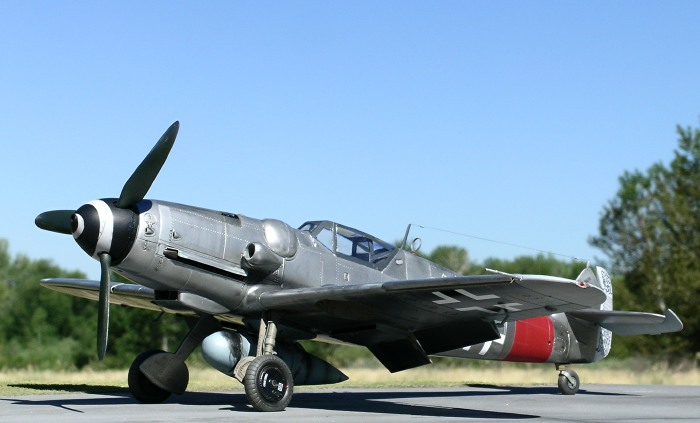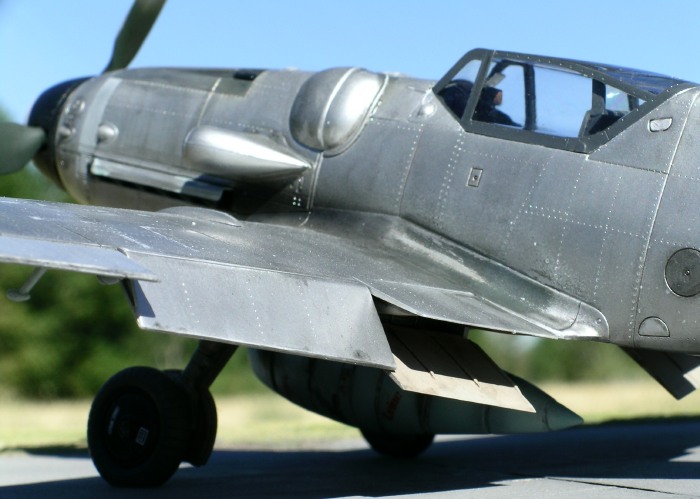|
Hasegawa's 1/32 Scale
Bf 109G-6
Metal Mosquito
Chaser
by
Ian Robertson
|
 |
|
Messerschmitt Bf 109G-6 |

Hasegawa's 1/32 scale Messerschmitt Bf 109G-6
is available online from Squadron.com
An operational Bf.109 in natural metal seems, well, unnatural! Yet here
is one.
“Red 8” was a Bf.109G-6 flown by Oblt. Kurt Gabler,
III./JG300, in July 1944. From photographs this aircraft appears to have
been sanded back from its original RLM74/75/76 finish, reportedly in an
effort to increase its speed for intercepting RAF Mosquitos. Traces of
paint are visible on the wing root and base of the elevators, and the
swastika has clearly been sanded down, leaving only a faint trace. Note
that the gun troughs and various access panels appear darker than the
rest of the aircraft because they are composed of darker metals (e.g.,
the gun troughs were iron). This same effect is seen in photographs of a
sanded down Bf109G belonging to the National Air and Space Museum (NASM),
adding support to the claim that “Red 8” was natural metal rather than
light grey.

“Red 8” is one of many unique Luftwaffe fighters featured in the new
Eagle Editions’ publication, “Jagdeschwader 300, Volume 1” by Jean-Yves
Lorant and Richard Goyat, with artwork by Tom Tullis and Richard Goyat.
The book, along with EagleCals decals, will make its appearance at the
IPMS Nationals in Atlanta. This model of “Red 8” will be on display at
the Eagle Editions table, so check it out!
I used the standard Hasegawa 1/32 scale Bf 109G-6
kit. Rivet details were added with a “Rosie the Riveter” tool because
one of the consequences of sanding down the aircraft was that its rivets
were more visible than usual. Another unique feature of the aircraft was
its retrofitted erla haube canopy, which required me to borrow one from
a Bf109G-14 kit.

Luckily, some Bf.109G-14s wore the early-style
canopy, so my G-14 kit won’t have to be relegated to the spares box.
Seatbelts were made from lead foil and buckles are from MDC. The spinner
and drop tank are resin replacements from Eagle Editions (Eagle Parts
20-32 and 21-32, respectively). Control surfaces on the tail were
repositioned to match photographs in the book. The antenna wire was made
from stretched sprue with pieces of light bulb filament for the tension
springs.
Paint Preparation and Finish
I primed the model with Tamiya Fine Surface Primer
and then polished it with a micromesh sanding cloth. The fuselage band
(50% Polly Scale oxide red and 50% RLM23) was sprayed and masked until
the natural metal finish had been applied. It is uncertain whether the
fuselage band and number 8 were the same color red. I opted for a
slightly darker fuselage band.
Alclad II lacquers were used for the natural metal finish. I used a
combination of Alclad duraluminum (the primary color), aluminum, dark
aluminum, semi-matte aluminum, and polished aluminum. Once the Alclad
had dried, I applied numerous washes of Tamiya black acrylic over the
entire model with a soft brush. I find this wash is an excellent way to
pick out details and create a realistically weathered natural metal
finish. Alclad can always be reapplied to areas that receive too much
wash, or these areas can be lightly sanded with a micromesh cloth.

The color on the fabric surfaces was a tough call. From photographs
these surfaces appear shiny and similar in shade to the natural metal
surfaces. I opted to use a glossy medium grey (lightened RLM75) in the
absence of better information.
 To
simulate the faded swastikas I cut a template from Tamiya tape and then
sprayed Polly Scale black on both sides of the tail. After a few minutes
(Polly Scale dries fast) I rubbed the swastikas down with a slightly
wetted micromesh sanding cloth to replicate their appearance in photos.
A similar technique was used for the upper wing crosses, although in
photos these crosses are not visible, perhaps owing to glare or because
they were in fact completely removed. I also used the technique to
replicate a sanded-down fuel triangle on the port fuselage. No
stenciling is visible on the aircraft. To
simulate the faded swastikas I cut a template from Tamiya tape and then
sprayed Polly Scale black on both sides of the tail. After a few minutes
(Polly Scale dries fast) I rubbed the swastikas down with a slightly
wetted micromesh sanding cloth to replicate their appearance in photos.
A similar technique was used for the upper wing crosses, although in
photos these crosses are not visible, perhaps owing to glare or because
they were in fact completely removed. I also used the technique to
replicate a sanded-down fuel triangle on the port fuselage. No
stenciling is visible on the aircraft.
Traces of RLM 74 were added to the wing roots, elevator roots, and
various patches on the wings. These areas were sanded down as described
for the swastikas, leaving only faint areas of paint.
The wingtips on “Red 8” are either white or a lightly-colored metal. I
opted for lightly-colored metal, as this was responsible for the light
wingtips on the sanded down NASM aircraft.
The tail was painted white (with a touch of grey) using Tamiya acrylic.
I used a lead pencil to draw the convoluted squiggle pattern as close as
possible to the pattern in photos. I then used a dark grey Gundam marker
from Gunze Sangyo (available at Hobbylink Japan) to make the squiggles
permanent. Afterward I simply erased the pencil marks. Worked like a
charm – a big thanks to Kent Eckhart for the idea and for lending me the
marker.

The canopy frame and interior of the cockpit were painted RLM66. The
drop tank and rack were painted RLM76. Oil streaks were added to the
drop tank by spraying thinned black paint over the surface.
Decals
EagleCals decals (#32-88) for “Red 8” will be
available in time for the IPMS Nationals in Atlanta. I used these decals
for all markings except the spiral on the spinner, which I masked and
painted since the decals were not ready when I was at this stage of
building the model. A spiral decal is included on the “Red 8” decal
sheet.
The natural metal finish on “Red 8” is a unique
scheme that is sure to catch the attention of Luftwaffe modelers. If
Wayne and Garth were modelers, here’s what they’d have to say about it:
Garth: “A 109 in natural metal?…no way”
Wayne: “Waaay”
Garth: “Awesome!”
Images were taken with a Nikon Coolpix 5400 digital
camera. The “unsharp mask” tool of Adobe Photoshop was used to restore
some of the clarity and crispness lost during image compression.
Click on the thumbnails
below to view larger images:
Slovakian and Bulgarian Aces of
World War 2
Aircraft of the Aces 56 |
|
|
|
|
Author: Jiri Rajlich
Illustrator: John Weal
US Price: $19.95
UK Price: £12.99
Publisher:
Osprey Publishing
Publish Date:
February 25, 2004
Details: 96 pages; ISBN: 1841766526 |
|
|
Model, Images and Text Copyright ©
2005 by Ian Robertson
Page Created 13 July, 2005
Last Updated 21 February, 2007
Back to HyperScale
Main Page
|
Home
| What's New |
Features |
Gallery |
Reviews |
Reference |
Forum |
Search